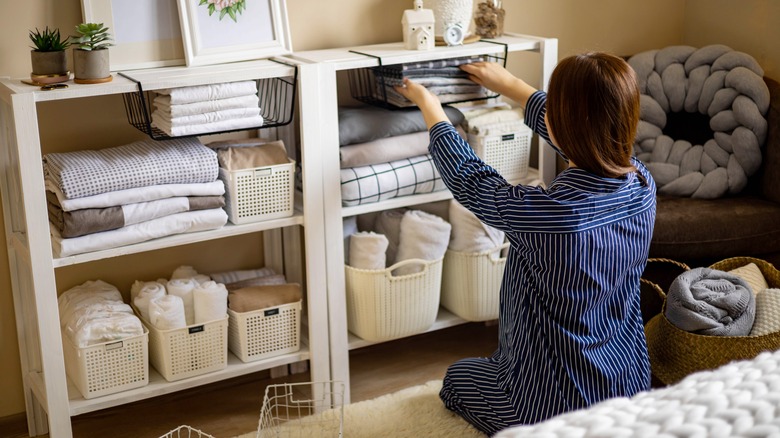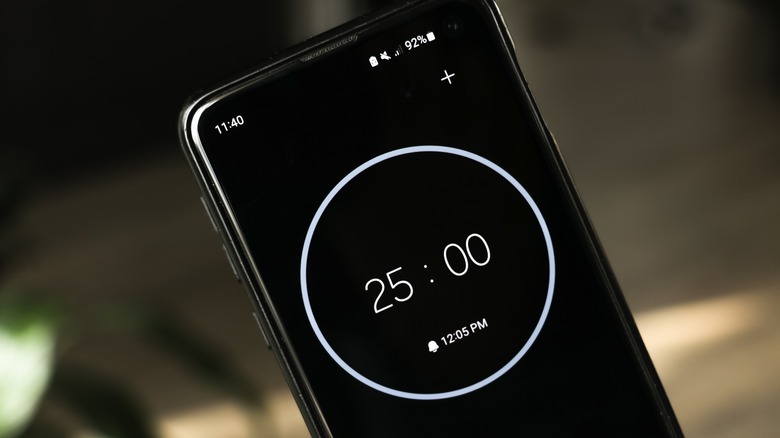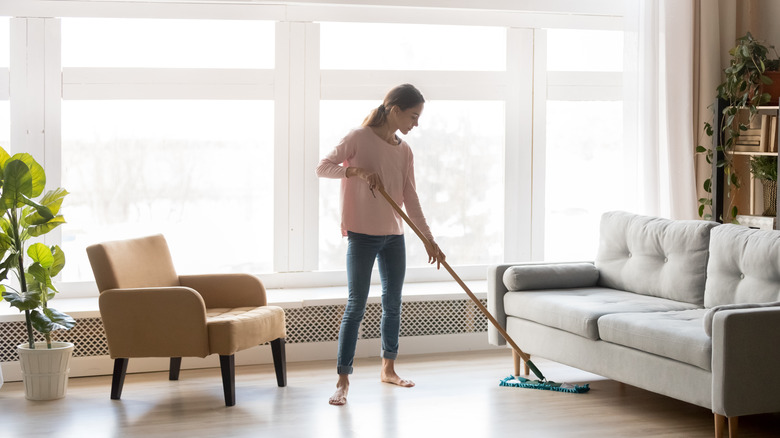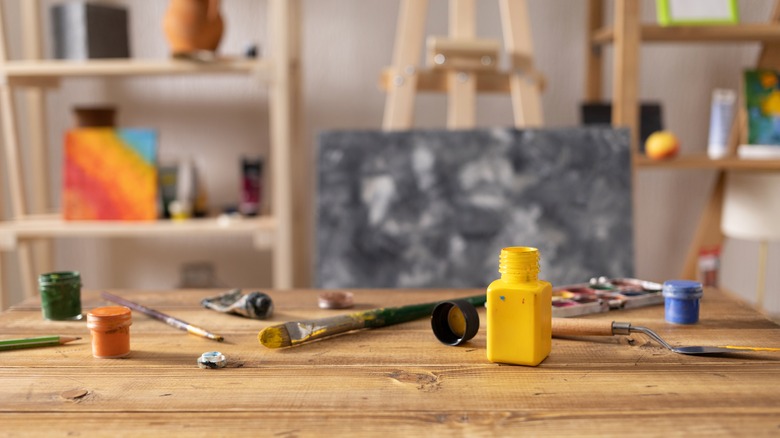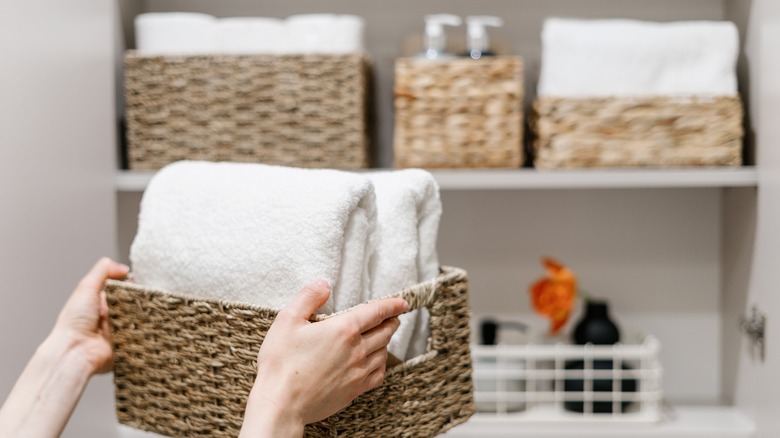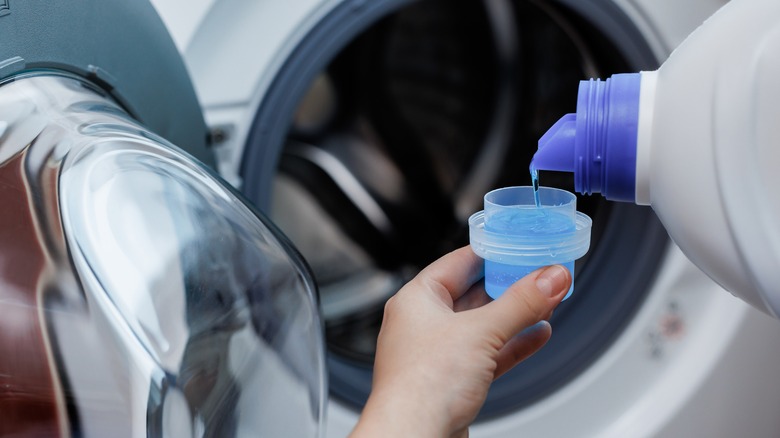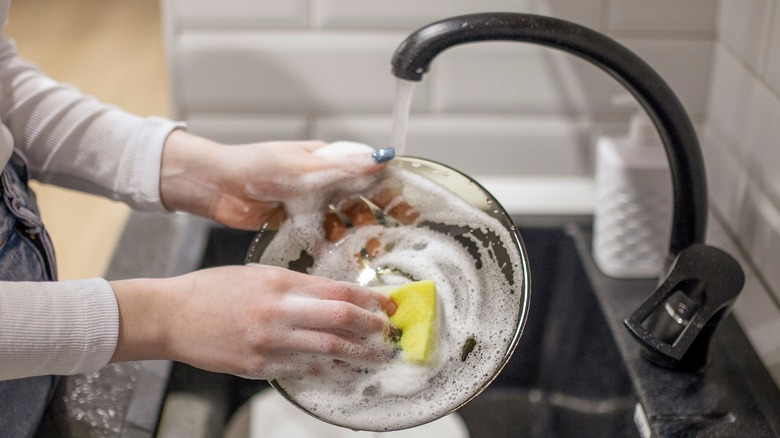15 Simple Habits Of People Who Keep Their Homes Clean And Organized
Clutter can impact almost every area of our lives, from how much time it takes to get dressed and find the car keys, to how we feel about ourselves and whether we're excited to have people over. Battling constant clutter eats up time, sparks frustration, and can infect our days with chaos. It can also counteract the money and time you put into design. According to a survey done by HuffPost, clutter is a major source of stress for Americans, and 47% of people reported feelings of worry around their homes being unclean and disorganized.
Maintaining a neat and clean home isn't just about keeping up with the Joneses. A study published in the "Personality and Social Psychology Bulletin (PSPB)" showed that disorganized spaces can take a toll on one's mental health by affecting cortisol levels. Elevated cortisol can also impact physical health outcomes.
If you're on a mission to beat clutter and master a cleaning routine, here's one of the most important things you need to know. Maintaining a tidy home boils down to habits, not (gasp) hacks. Cup hooks and Command Strips can help you get organized, but how do you keep things that way? Tidy people tend to have a common set of specific habits that are the secret sauce behind their pristine spaces. Ready to tap into some of these tendencies? Close that viral cleaning hack video and keep reading.
Making your bed, no matter what
Ask any tidy friend or family member whether they make their bed in the mornings, and the answer is probably yes. Tucking in the sheets first thing is a typical "tidy person" move. Not only does it get the task out of the way immediately (and leaves your bedroom looking inviting,) but it also sets you up for orderly success for the rest of your day.
The simple act of making your bed can help you build tidying momentum. With the pillows plumped and the comforter arranged, suddenly it makes sense to pick up last night's clothes off the floor, straighten your slippers, or take that towel back to the bathroom.
If bed-making isn't a natural instinct, here are a few actionable tips for making it a habit. First, see if you can link it to something you do without fail as you start your day, such as making coffee. While the water's boiling or the machine's dripping, head back into the boudoir and shake out those sheets. Do you typically find making the bed a pointless task since it never seems to look nice? Another way you can spark motivation is by treating yourself to some cozy bed-styling accouterments, such as textured throws and trendy pillows. One of the easiest designer tips for making your bed the right way is to mix fibers and add interest through blankets and throw pillows.
Setting tidying timers
If you want to get (and stay) ultra-organized, take a page out of clean-with-me content creators and try out timed tidying. Setting a timer can help you stay focused and stop you from descending down a cleaning rabbit hole. Have you ever set out to tackle the kitchen and, two hours later, found yourself looking at photo albums with the dishes still piled up? This is the perfect example of how easy it can be to get sidetracked during chores!
Having a timer running tells your mind that you've got a deadline. Not only can this increase focus, but it can also make you work faster and more efficiently. Parkinson's law states that tasks will take as much time as you set aside for them. In other words, if you give yourself the morning to clean the kitchen, it'll take half a day. If you give yourself 25 minutes, you may get it done within 30.
Tidying with a stopwatch is also a great option for people who begrudge the time it takes to do house chores. If you feel like cleaning is eating up valuable time you could be using for something else, a timer can give you a manageable deadline that doesn't feel like it would take up the entire evening. This will make you more willing to jump into tidying, helping you lock in the new habit.
Cleaning as you go
If you want to keep your weekends clear and your counters shining, it's time to try out micro-cleaning. Besides tidying up every day, see what cleaning chores you can fit into your everyday activities. By tackling tasks throughout the week, you can stay on top of things and always feel like your space is reasonably clean. This could look like doing the dusting on a Monday, cleaning windows on Wednesday, etc. Or, you can take a room-by-room approach. You might want to do some tasks on a semi-daily basis, like Swiffering the main living area.
Besides these scheduled chores, watch out for small "spontaneous" cleaning acts you can do right away instead of leaving for later. Such as removing hair from the drain as soon as you're done showering or wiping the backsplash after doing dishes. If you're tempted not to do a task like this, ask yourself, "Will it take less than two minutes?" If the answer is yes, then it's probably easier to take action than to procrastinate.
Creating a well-stocked cleaning caddy can help you get down to business swiftly without having to waste time gathering cleaning supplies. It can also pay to keep a few cleaning essentials in key areas, like your primary bathroom. A couple of microfiber cloths stored in the vanity can make quickly wiping down the counter or removing dust from the window sill that much easier.
Cleaning as you cook
The cleaning-as-you-go technique also has big payoffs in the kitchen. If you've ever watched a truly tidy person cook, you might have noticed that they didn't leave a trail of dirty pots and utensils in their wake. Instead, they probably placed items straight into the dishwasher as they used them, quickly washed spoons under the faucet, wiped up spills as they happened, etc.
If you want to get into the habit of cleaning as you cook, start with a fresh slate. Unload the dishwasher, empty the drying rack, and deal with any dishes that are in the sink. Run some warm water so you can wash utensils while you cook or rinse off excess food before putting items in the dishwasher. Then, like a pro chef, set yourself up for less mess by employing the mise en place practice, which is to assemble and prep all your ingredients before cooking. That way, you can clean while food is cooking, rather than chopping the next ingredient.
Using the one-touch rule
This is a variation of the "put it away, not down" rule. Both of these concepts are key tenants of the tidy. As its name suggests, the one-touch rule decrees that you only handle items "one time" while tidying.
Rather than moving a misplaced item to another counter or another room, you immediately put it back where it belongs. By dealing with the object right away, you're not leaving work for your future self to do. The one-touch rule can help you avoid almost finishing tidying tasks. For instance, if you're taking your shoes off, put them on the shoe rack, not next to it. This saves you from having to pick them up later.
Incoming mail is another place you can practice the one-touch rule. Instead of dumping the pile on your counter, first check if there's any junk mail you can chuck. Even better, sort through the rest and see if there are actions you're able to take immediately, like putting a bill you need to pay on your keyboard.
Maintaining a weekly fridge cleaning schedule
Tidy people don't just have neat living rooms; their fridge interiors usually look like they come straight out of Pinterest. Having a tidy refrigerator is super satisfying, and it can help cut down on food waste. If you want to achieve this holy grail of organization, consistency is key. Instead of letting the leftovers build up and the produce pushed to the back, take the same approach to tidying your fridge as cleaning your counters. Do it often. Some people like to straighten their fridges on a daily basis so they can check what produce they need to use up. If you don't have the dedication for daily refrigerator decluttering, weekly cleanings will also work just fine.
If you buy groceries on a specific day, this could be a good time to tackle your fridge. Throwing out old food and wiping the shelves will give you a clean slate for restocking. Besides this, you should also aim to give your refrigerator a deep clean every few months.
Straightening the house before bed
Does it feel like no matter how much you clean, you can never start the day with a fresh space? If you're sick of waking up to a sad-looking sofa, socks on the floor, and sticky marks on the kitchen tiles, here's a top tidy person secret. Before you go to bed, give your space a quick once-over. You don't need to be decluttering drawers at this hour or scrubbing out the shower. Instead, the aim of the game is to do the bare minimum to get things in order for the next day.
Quickly plump the sofa throw pillows, fold that blanket you were using, and take any stray cups to the dishwasher. If the kitchen floor looks like a spaghetti-sauce-filled bomb hit it, you can give it a quick run with the Swiffer, but the idea isn't to get everything sparkling within an inch of its life. You're merely doing a quick touch-up so you're not greeted by a mess in the morning.
Tidying up after each task
Mom was right. It really does pay to pack things away as soon as you're done with them. This doesn't just apply to tasks; it can also extend to everyday elements of your routine. Did you try on a few different outfits before you were happy with your look? Instead of leaving the discarded clothes in a pile to be put away at a vague point in the future, do it right away.
Putting things away immediately can come naturally to type-A personalities, but what if you're decidedly type-B? One way to train yourself to tidy up after tasks is to make a rule that nothing is really "done" until you've packed back what you were using for the job. This can apply to craft projects, yard chores, decluttering sprees — you name it. Make sure you factor in the extra time this will take, so you don't run short and break your new habit.
This rule can even extend to your car. Tired of dealing with a dirty ride? Make it a rule to scan your car when you get home. Remove everything that doesn't need to stay in it for your next trip. Remove trash, dust any crumbs off your seat, and give the floor mats a quick shake if they need it. To make things easier for next time, kit out your car with a small trash can and a pack of disposable sanitary wipes for quickly cleaning spills.
Storing things in easy reach
The easier it is to pack stuff away, the more likely you are to keep things neat. If items aren't stored in logical, convenient places that fit the flow of your life, this can create friction. Having logically placed, designated places for things cuts down on decision fatigue. You don't have to decide each time where to place something or wonder where you put it last. Zeroing in on the perfect place to store items can take time and thought, but it doesn't have to be perfect right away. The important thing is to start making homes for things. You can always tweak the placement later on.
The key is to make it as convenient as possible for you to put things in their places. For instance, if your shoe storage solution is far away from where you take off your shoes, they'll probably always be scattered on the floor. Find ways to house things close to where they naturally "land" in your home. A laundry hamper next to where you usually get undressed is better than one two rooms away. Hooks for your coat as you come in mean fewer scattered pieces of outerwear. You should also create landing zones for things like your car keys, wallet, and sunglasses. Instead of strewing them on your kitchen counter, set up a tray or bowl in your entryway.
Keeping surfaces clutter-free
Although you should store things in accessible places, this doesn't mean you must keep stuff on your counters. Taking a minimalist approach to surfaces can save you a heap of cleaning time and help you stay tidy. Wiping down a sparse counter that isn't overloaded with appliances, cookbooks, and kitchen decor is far less of a daunting task. Instead of having to move everything, you can get the surface sparkling in seconds.
Less clutter on surfaces also frees up visual bandwidth, making it easier to see when something's out of place or needs to be packed away. The more stuff there is for your eyes to land on, the easier it is for additional objects to get absorbed into the morass. The first step to achieving zen-like, uncluttered counters is to ruthlessly evaluate what you currently store on them. Is there anything that really needs to be there? Remove everything except what absolutely has to stay, and then choose one or two styling items, like a fruit bowl, vase, coffee table book, etc.
If you have a collection of smaller items that need to be out, or which you're displaying, leverage the tray tip. Trays help to corral loose items, signaling to your eyes that everything's in order. They also make cleaning easier. Instead of having to move several small objects, you can just grab the whole tray.
Doing laundry daily
Can you imagine a tidy person with an overflowing laundry basket? Probably not. Running the washer as soon as there's enough for a load adds up to the same amount of work as doing a mammoth laundry session, but it feels much more manageable. If this doesn't suit your routine, you can earmark specific days for laundry.
Staying on top of laundry can be tough, especially if you have a lot of other things going on. To get into the habit, try taking two weeks to make your laundry basket a priority. As soon as the level rises, do a wash. Have separate bins for lights, darks, and colors. Try to commit to folding as soon as the laundry is dry. Wear clothes more than once and have an in-between hamper for clothes that are being worn so they don't lay about.
Look for ways you can streamline your laundry routine. For instance, if you have a lot of hanging space and loathe folding, put the majority of your items on hangers. This can also save a lot of time if you like air-drying clothes, as you can slip them onto the hangers while damp, saving you the hassle of using clothespins. If you fold most of your clothes, look for a folding method that can help you stay organized, such as the Mario Kondo folding technique.
Not rushing
Nothing can create a mess faster than someone in a rush. Think of the last time you were late leaving the house. Did you scratch frantically through your sock drawer? Or turn your living room upside down looking for your keys? Any time you do something in a rush, keeping things neat flies out the window. And forget tidying as you go. You simply don't have time for that! On the flip side, slowing down will allow you to interact with your space in a focused, careful way.
Nobody's perfect, and sometimes you just can't avoid a time crunch. But, creating a schedule that allows just a few extra minutes of buffer time can work wonders. Another way to give yourself more time is through things like meal prepping, laying your clothes out the night before, packing your bag ahead of time, etc. Finally, if you're in the habit of rushing, your body might find it hard to physically slow down. "Hurry sickness," which is when your body is in a constant state of rushing, isn't something you can reverse all at once, but training your body into a state of calm by intentionally moving a little slower and taking care of your space is a great start.
Tidying with intention
Speaking of intention, the attitude you have towards cleaning and tidying can have a subtle yet powerful impact on your space. Have you noticed that tidy people tend to take great care of their stuff? If you want to get better at tidying, get into the habit of changing your mental attitude.
Instead of racing through chores, approach tidying as an intentional act of care towards your space and everything in it. It's a great moment to revisit all the things you carefully curated and give appreciation for the home you built. This type of mindfulness shifts your mindset — tidying is no longer a cumbersome chore you have to slog through, but a moment of treasuring. So the next time you're folding laundry or clearing up lunch, see if you can turn the task into an opportunity to be present and practice positive intentions towards your space.
Get addicted to decluttering
The more stuff there is in your space, the harder it will be to keep it straight. Ask any tidy person, and you'll probably find they're addicted to decluttering. Some people find success by doing a mega declutter marathon. If you don't have the time (or the energy) for something like this, you can also take the baby-step approach. Instead of trying to declutter your whole home in one go, start small with something super manageable, like your cutlery drawer or kitchen corner cupboard. As you slowly declutter these small spaces, you'll gain momentum. This approach also means you don't have to turn the whole household upside down, making things worse before they get better. Doing small declutters whenever you have a chance also builds your decluttering muscles over time, turning it into a habit rather than a chore.
If clutter is your kryptonite, and your natural instinct is to hold on to stuff with all your might, consider the one-in-one-out strategy. Any time you buy or receive a new item, make it a rule to get rid of something in the same category. You can apply this approach to clothes, kitchen items, electronics — you name it. And watch out for sneaky categories like holiday decorations. Reviewing and decluttering seasonal decor helps keep those boxes under control and may even prevent unnecessary impulse buys.
Finding ways to make cleaning enjoyable
If your brain doesn't naturally light up at the thought of decluttering, and deep cleaning the kitchen sounds like purgatory warmed up, here's a hot tip. Try to find ways you can trick yourself into having a good time. That true crime podcast you've been wanting to listen to? Pop in some ear pods before you start mopping the floors. Or maybe you've got a massive pile of laundry to fold? Now might be the time to turn on your favorite Netflix show. Playing music is another way to inject some fun and enjoyment into tidying. A survey by Jelmar revealed that 80% of people throw on some jams when it's time to bust dust and dirt. If you're not sure what tunes to rock, YouTube and Spotify have a plethora of cleaning playlists you can sample.
The secret is finding something that truly transforms the activity into something you're looking forward to. Our brains are wired to run on dopamine, which is the reward neurochemical. By linking something you enjoy (like your favorite podcast) with cleaning, you can neurochemically associate chores with happy hormones, instead of feelings of frustration or overwhelm.
